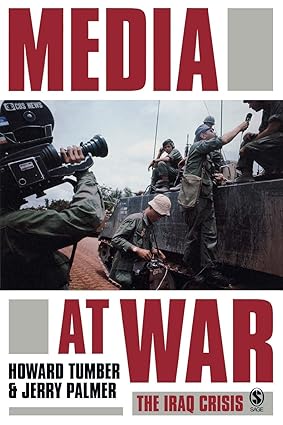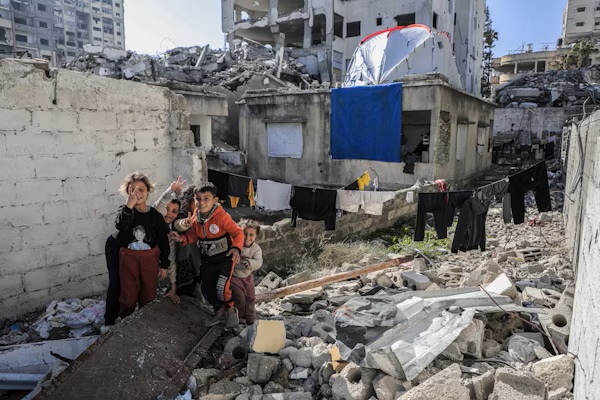Timeless Read : Book Review

Media at War: The Iraq Crisis
Howard Tumber and Jerry Palmer (London: Sage Publications, 2004
By Rohit Dhuliya
Twenty years ago, Tumber and Palmer wrote about the Iraq War and showed how journalists were kept close to soldiers (through ‘embedding’), how the language of news copied the military’s words (‘collateral damage’, ‘regime targets’), and how some lives were treated as more important than others.
Everything they described is still happening today – only louder and faster.
We now see reporters taken on quick helicopter trips over Gaza, soldiers posting their own war videos straight to TikTok and Instagram, and the same old phrases (‘human shields’, ‘precision strikes’, ‘right to defend’) moving from government statements into headlines in minutes. Palestinian, Yemeni or Sudanese deaths are still mostly numbers; Western or Israeli deaths still get names, photos and human stories.
Smartphones and social media have put a camera in everyone’s hand, but they have not fixed the bigger problem the book pointed out: when journalists – or even ordinary people posting videos – get too close to one side’s guns, money or algorithms, the picture of the war gets crooked.
In short, a book written about 2003 feels like it was written about 2025. It is clear, fair and, sadly, still completely up to date. Anyone trying to understand today’s wars through their phone screen needs to read it.”
Few topics expose the uneasy marriage between journalism and power quite like wartime reporting. In Media at War: The Iraq Crisis, Howard Tumber and Jerry Palmer deliver a sharp, timely dissection of how Western media—primarily British and American—covered the 2003 invasion of Iraq and its turbulent aftermath.
Published barely a year after the fall of Baghdad, the book captures the profession at a moment of profound crisis: the collapse of public trust after the failure to find weapons of mass destruction, the rise of embedded reporting, and the emergence of 24-hour news networks as both witnesses and unwitting propagandists.

The authors organise their analysis around three interlocking themes: access, framing, and professional ideology. Their most original contribution is a detailed mapping of the British Ministry of Defence’s and Pentagon embedding programmes.
Tumber and Palmer argue convincingly that while embedding produced vivid, soldier’s-eye reportage, it also tethered journalists to the military’s logistical and emotional orbit. The result was a paradoxical mix of tactical immediacy and strategic blindness: viewers saw the “shock and awe” fireworks in real time but rarely the broader political context or civilian cost.
A standout chapter examines the short-lived phenomenon of “hotel journalism” in Baghdad and contrasts it with the riskier, more independent work of “unilaterals.” The tragic death of ITN’s Terry Lloyd becomes a poignant case study in the price paid by those who refused coalition rules. Elsewhere, the authors unpack the language of war—how terms such as “coalition forces,” “regime targets,” and “collateral damage” migrated seamlessly from military press officers to news bulletins, naturalising a highly partisan vocabulary.
Their content analysis of BBC and ITN bulletins reveals systematic asymmetries: Iraqi casualties were almost never individuated, while every coalition death received a name, hometown, and grieving family.
The book is not without limitations. Written in the white heat of 2003–2004, it necessarily lacks historical distance and cannot engage with later revelations (Abu Ghraib, the insurgency’s full ferocity). Some readers may find the theoretical framework—drawing on Glasgow Media Group traditions and Hallin’s spheres of legitimate controversy—familiar. Yet these are minor quibbles; the speed of publication is itself a virtue, catching the media in the act of soul-searching while the wounds are still raw.
More than twenty years on, the core dilemmas dissected in Media at War have not merely persisted; they have metastasised. The embedding model pioneered in 2003 has evolved into even tighter forms of military-media integration: journalists flown in on Osprey helicopters for “battlefield tours” in Gaza, live feeds from helmet cams in Ukraine, or TikTok dispatches by individual soldiers that bypass traditional gatekeepers entirely. Where Tumber and Palmer documented the dangers of physical and logistical dependence, today we must add algorithmic and financial dependence—outlets chasing virality rather than verification, while state actors flood platforms with coordinated narratives at speeds that make the old CENTCOM briefings look quaint.

The linguistic sanitisation the authors traced lives on in phrases such as “human shields,” “military operations in populated areas,” and “right to defend itself,” terms that still migrate effortlessly from official statements into headlines. Most disturbingly, the asymmetry in valuing human life that Tumber and Palmer quantified in 2003–2004 remains almost unchanged: Palestinian, Yemeni, or Sudanese dead are still rendered as abstract statistics, while every Western or Israeli casualty generates names, photographs, and crowdfunding campaigns.
In an age when anyone with a smartphone can become an instantaneous war correspondent, Media at War reminds us that technological democratisation has not solved the older, structural problem the book identified: proximity to power—whether physical, logistical, or algorithmic—continues to distort the picture more than it clarifies it.
Ultimately, Media at War stands as both diagnosis and enduring cautionary tale. Tumber and Palmer refuse easy scapegoating of journalists; instead they reveal a profession structurally incentivised to prioritise official sources, dramatic visuals, and national identification in times of conflict. Two decades later, their core insight remains uncomfortably, urgently relevant: the closer journalism gets to the battlefield, the harder it becomes to see the war.
About the Author
Rohit Dhuliya is an award-winning filmmaker and writer whose documentaries tackle pressing social and political issues. His films have screened at major festivals worldwide, including Mumbai, Swedish, Signs (Kerala), Monadnock (USA), and Global Peace Film Festival (USA). Wounds of Change won the Rising Star Award at the Canada International Film Festival, and Gandhi Rediscovered took the Short Documentary Award at Portland and Golden Sparrow Film Festivals.



